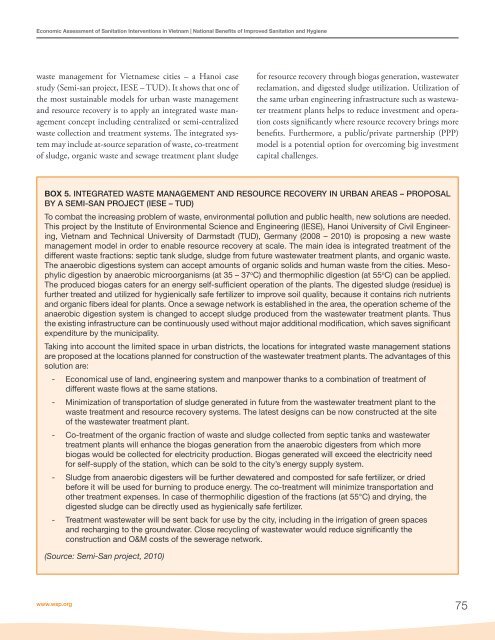Economic Assessment of Sanitation Interventions in Vietnam - WSP
Economic Assessment of Sanitation Interventions in Vietnam - WSP
Economic Assessment of Sanitation Interventions in Vietnam - WSP
You also want an ePaper? Increase the reach of your titles
YUMPU automatically turns print PDFs into web optimized ePapers that Google loves.
<strong>Economic</strong> <strong>Assessment</strong> <strong>of</strong> <strong>Sanitation</strong> <strong>Interventions</strong> <strong>in</strong> <strong>Vietnam</strong> | National Benefits <strong>of</strong> Improved <strong>Sanitation</strong> and Hygienewaste management for <strong>Vietnam</strong>ese cities – a Hanoi casestudy (Semi-san project, IESE – TUD). It shows that one <strong>of</strong>the most susta<strong>in</strong>able models for urban waste managementand resource recovery is to apply an <strong>in</strong>tegrated waste managementconcept <strong>in</strong>clud<strong>in</strong>g centralized or semi-centralizedwaste collection and treatment systems. The <strong>in</strong>tegrated systemmay <strong>in</strong>clude at-source separation <strong>of</strong> waste, co-treatment<strong>of</strong> sludge, organic waste and sewage treatment plant sludgefor resource recovery through biogas generation, wastewaterreclamation, and digested sludge utilization. Utilization <strong>of</strong>the same urban eng<strong>in</strong>eer<strong>in</strong>g <strong>in</strong>frastructure such as wastewatertreatment plants helps to reduce <strong>in</strong>vestment and operationcosts significantly where resource recovery br<strong>in</strong>gs morebenefits. Furthermore, a public/private partnership (PPP)model is a potential option for overcom<strong>in</strong>g big <strong>in</strong>vestmentcapital challenges.BOX 5. INTEGRATED WASTE MANAGEMENT AND RESOURCE RECOVERY IN URBAN AREAS – PROPOSALBY A SEMI-SAN PROJECT (IESE – TUD)To combat the <strong>in</strong>creas<strong>in</strong>g problem <strong>of</strong> waste, environmental pollution and public health, new solutions are needed.This project by the Institute <strong>of</strong> Environmental Science and Eng<strong>in</strong>eer<strong>in</strong>g (IESE), Hanoi University <strong>of</strong> Civil Eng<strong>in</strong>eer<strong>in</strong>g,<strong>Vietnam</strong> and Technical University <strong>of</strong> Darmstadt (TUD), Germany (2008 – 2010) is propos<strong>in</strong>g a new wastemanagement model <strong>in</strong> order to enable resource recovery at scale. The ma<strong>in</strong> idea is <strong>in</strong>tegrated treatment <strong>of</strong> thedifferent waste fractions: septic tank sludge, sludge from future wastewater treatment plants, and organic waste.The anaerobic digestions system can accept amounts <strong>of</strong> organic solids and human waste from the cities. Mesophylicdigestion by anaerobic microorganisms (at 35 – 37 o C) and thermophilic digestion (at 55 o C) can be applied.The produced biogas caters for an energy self-sufficient operation <strong>of</strong> the plants. The digested sludge (residue) isfurther treated and utilized for hygienically safe fertilizer to improve soil quality, because it conta<strong>in</strong>s rich nutrientsand organic fibers ideal for plants. Once a sewage network is established <strong>in</strong> the area, the operation scheme <strong>of</strong> theanaerobic digestion system is changed to accept sludge produced from the wastewater treatment plants. Thusthe exist<strong>in</strong>g <strong>in</strong>frastructure can be cont<strong>in</strong>uously used without major additional modification, which saves significantexpenditure by the municipality.Tak<strong>in</strong>g <strong>in</strong>to account the limited space <strong>in</strong> urban districts, the locations for <strong>in</strong>tegrated waste management stationsare proposed at the locations planned for construction <strong>of</strong> the wastewater treatment plants. The advantages <strong>of</strong> thissolution are:- <strong>Economic</strong>al use <strong>of</strong> land, eng<strong>in</strong>eer<strong>in</strong>g system and manpower thanks to a comb<strong>in</strong>ation <strong>of</strong> treatment <strong>of</strong>different waste flows at the same stations.- M<strong>in</strong>imization <strong>of</strong> transportation <strong>of</strong> sludge generated <strong>in</strong> future from the wastewater treatment plant to thewaste treatment and resource recovery systems. The latest designs can be now constructed at the site<strong>of</strong> the wastewater treatment plant.- Co-treatment <strong>of</strong> the organic fraction <strong>of</strong> waste and sludge collected from septic tanks and wastewatertreatment plants will enhance the biogas generation from the anaerobic digesters from which morebiogas would be collected for electricity production. Biogas generated will exceed the electricity needfor self-supply <strong>of</strong> the station, which can be sold to the city’s energy supply system.- Sludge from anaerobic digesters will be further dewatered and composted for safe fertilizer, or driedbefore it will be used for burn<strong>in</strong>g to produce energy. The co-treatment will m<strong>in</strong>imize transportation andother treatment expenses. In case <strong>of</strong> thermophilic digestion <strong>of</strong> the fractions (at 55°C) and dry<strong>in</strong>g, thedigested sludge can be directly used as hygienically safe fertilizer.- Treatment wastewater will be sent back for use by the city, <strong>in</strong>clud<strong>in</strong>g <strong>in</strong> the irrigation <strong>of</strong> green spacesand recharg<strong>in</strong>g to the groundwater. Close recycl<strong>in</strong>g <strong>of</strong> wastewater would reduce significantly theconstruction and O&M costs <strong>of</strong> the sewerage network.(Source: Semi-San project, 2010)www.wsp.org75
















